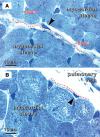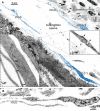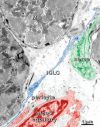Interstitial Cajal-like cells (ICLC) in myocardial sleeves of human pulmonary veins
- PMID: 18671760
- PMCID: PMC3918093
- DOI: 10.1111/j.1582-4934.2008.00444.x
Interstitial Cajal-like cells (ICLC) in myocardial sleeves of human pulmonary veins
Abstract
We present here evidence for the existence of a new type of interstitial cell in human myocardial sleeves of pulmonary veins: interstitial Cajal-like cell (ICLC). This cell fulfils the criteria for positive diagnosis of ICLC, including CD 117/c-kit positivity. Transmission electron microscopy revealed typical ICLC with 2 or 3 very long processes (several tens of mm) suddenly emerging from the cellular body. Also, these processes appear moniliform but extremely thin (0.1-0.4 mm) under the resolving power of the usual microscopy. Cell processes establish close spatial relationships between each other, as well as with capillaries and nerve endings. ICLC appear located among the myocardial cells and particularly at the border between the myocardial sleeve and pulmonary vein wall.
Figures






References
-
- Popescu LM, Ciontea SM, Cretoiu D. Interstitial Cajal-like cells in human uterus and fallopian tube. Ann N Y Acad Sci. 2007;1101:139–65. - PubMed
Publication types
MeSH terms
Substances
LinkOut - more resources
Full Text Sources

